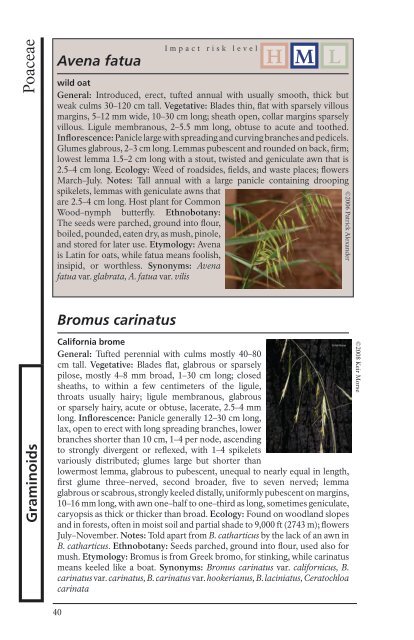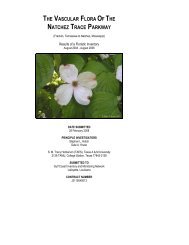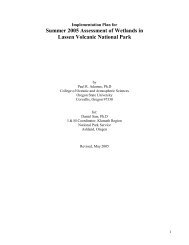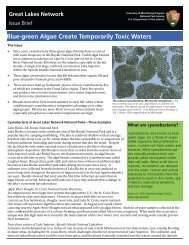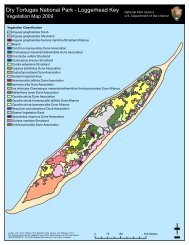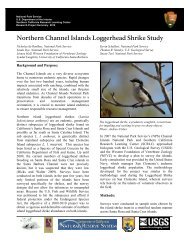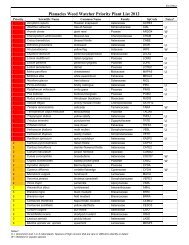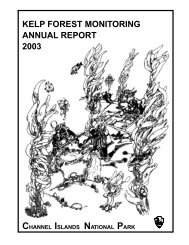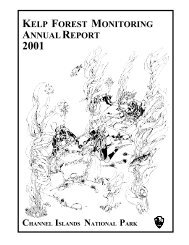Plants of Casa Grande Ruins National Monument - NPS Inventory ...
Plants of Casa Grande Ruins National Monument - NPS Inventory ...
Plants of Casa Grande Ruins National Monument - NPS Inventory ...
You also want an ePaper? Increase the reach of your titles
YUMPU automatically turns print PDFs into web optimized ePapers that Google loves.
Poaceae<br />
Graminoids<br />
Avena fatua<br />
wild oat<br />
General: Introduced, erect, tufted annual with usually smooth, thick but<br />
weak culms 30–120 cm tall. Vegetative: Blades thin, flat with sparsely villous<br />
margins, 5–12 mm wide, 10–30 cm long; sheath open, collar margins sparsely<br />
villous. Ligule membranous, 2–5.5 mm long, obtuse to acute and toothed.<br />
Inflorescence: Panicle large with spreading and curving branches and pedicels.<br />
Glumes glabrous, 2–3 cm long. Lemmas pubescent and rounded on back, firm;<br />
lowest lemma 1.5–2 cm long with a stout, twisted and geniculate awn that is<br />
2.5–4 cm long. Ecology: Weed <strong>of</strong> roadsides, fields, and waste places; flowers<br />
March–July. Notes: Tall annual with a large panicle containing drooping<br />
spikelets, lemmas with geniculate awns that<br />
are 2.5–4 cm long. Host plant for Common<br />
Wood–nymph butterfly. Ethnobotany:<br />
The seeds were parched, ground into flour,<br />
boiled, pounded, eaten dry, as mush, pinole,<br />
and stored for later use. Etymology: Avena<br />
is Latin for oats, while fatua means foolish,<br />
insipid, or worthless. Synonyms: Avena<br />
fatua var. glabrata, A. fatua var. vilis<br />
40<br />
Bromus carinatus<br />
Impact risk level<br />
H M L<br />
California brome<br />
General: Tufted perennial with culms mostly 40–80<br />
cm tall. Vegetative: Blades flat, glabrous or sparsely<br />
pilose, mostly 4–8 mm broad, 1–30 cm long; closed<br />
sheaths, to within a few centimeters <strong>of</strong> the ligule,<br />
throats usually hairy; ligule membranous, glabrous<br />
or sparsely hairy, acute or obtuse, lacerate, 2.5–4 mm<br />
long. Inflorescence: Panicle generally 12–30 cm long,<br />
lax, open to erect with long spreading branches, lower<br />
branches shorter than 10 cm, 1–4 per node, ascending<br />
to strongly divergent or reflexed, with 1–4 spikelets<br />
variously distributed; glumes large but shorter than<br />
lowermost lemma, glabrous to pubescent, unequal to nearly equal in length,<br />
first glume three–nerved, second broader, five to seven nerved; lemma<br />
glabrous or scabrous, strongly keeled distally, uniformly pubescent on margins,<br />
10–16 mm long, with awn one–half to one–third as long, sometimes geniculate,<br />
caryopsis as thick or thicker than broad. Ecology: Found on woodland slopes<br />
and in forests, <strong>of</strong>ten in moist soil and partial shade to 9,000 ft (2743 m); flowers<br />
July–November. Notes: Told apart from B. catharticus by the lack <strong>of</strong> an awn in<br />
B. catharticus. Ethnobotany: Seeds parched, ground into flour, used also for<br />
mush. Etymology: Bromus is from Greek bromo, for stinking, while carinatus<br />
means keeled like a boat. Synonyms: Bromus carinatus var. californicus, B.<br />
carinatus var. carinatus, B. carinatus var. hookerianus, B. laciniatus, Ceratochloa<br />
carinata<br />
©2006 Patrick Alexander<br />
©2008 Keir Morse


